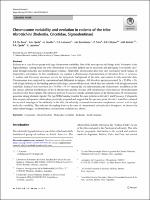Chromosome variability and evolution in rodents of the tribe abrotrichini (rodentia, cricetidae, sigmodontinae)
Date
2019-11-30Author
Da Rosa, Fernando Antonio
Ojeda, Agustina Alejandra
Novillo, Agustina
Labaroni, Carolina Alicia
Buschiazzo, Leandro Maciel
Teta, Pablo Vicente
Cálcena, Eugenio Nicolás
Bolzán, Alejandro Daniel
Ojeda, Ricardo Alberto
Lanzone, Cecilia
Metadata
Show full item recordAbstract
Rodents are a very diverse group with large chromosome variability. One of the most species rich linage in the Neotropics is the Sigmodontinae. Among them, the tribe Abrotrichini was recently defined and its taxonomy and phylogeny were mostly elucidated through molecular and morphological evidence. Meanwhile, chromosome data were only secondarily used because of fragmentary information. In this contribution, we conduct a chromosome characterization of Abrothrix hirta, A. olivacea, A. andina, and Paynomys macronyx, review the cytogenetic background of the tribe, and contrast it with molecular data.
Chromosomes were analyzed by conventional and differential techniques. All Abrothrix species presented 2n = 52/FNa = 56, with a high similarity in the banding patterns reflecting a conserved karyotype, which does not coincide with its high molecular variability. In turn, P. macronyx have 2n = 54/FNa = 58–59, varying due to a heteromorphic pair of autosomes. In addition, in this last species, different morphologies of the X chromosome and the presence of B chromosomes were detected. Heterochromatin was involved in these variants. The telomeric probe in P. macronyx marks terminal regions of all chromosomes. B chromosomes generated strong telomeric signals. The Ag-NORs banding revealed the same patterns in Abrothrix and Paynomys. Cytogenetic data support phylogenetic relationships previously proposed and suggest that the specious genus Abrothrix could have retained the ancestral karyotype of the subfamily. In the tribe, the relatively conserved chromosome complement contrasts with its high molecular variability. This indicates decoupling between the rates of chromosomal and molecular divergence, as observed in other rodent lineages. In abrotrichines, chromosome evolution was slower.
Collections
The following license files are associated with this item:



